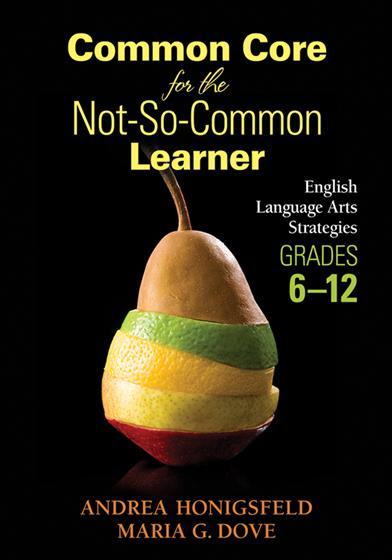
Hands-on, Practical Guidance for Educators
From math,
literacy, equity, multilingual learners, and SEL, to assessment, school counseling,
and education leadership, our books are research-based and authored by experts
on topics most relevant to what educators are facing today.
Common Core for the Not-So-Common Learner, Grades 6-12
Make the Common Core work for ELLs, students with disabilities, and other struggling learners, with flexible teaching strategies that cover the 32 ELA anchor standards.
- Grade Level: 6-12
- ISBN: 9781452257815
- Published By: Corwin
- Year: 2013
- Page Count: 280
- Publication date: September 05, 2013
Review Copies
Description
New hope for our students who struggle most
Under the best of circumstances meeting the Common Core can be a challenge. But if you’re a teacher of academically or linguistically diverse students—and who isn’t these days—then that “challenge” may sometimes feel more like a “fantasy.” Finally, here are two expert educators who are brave enough, knowledgeable enough, and grounded enough to tackle this issue.
The grades 6-12 follow-up to Dove and Honigsfeld’s best-selling K-5 volume, this outstanding resource is packed with all the advice, tools, and strategies you need to build struggling learners’ language skills in today’s Common Core climate. Armed with this book, you’ll
- Better understand the 32 ELA anchor standards
- Learn more about the specific skills “uncommon learners” need to master them
- Discover new research-based teaching strategies aligned to each standard
- Maximize the effectiveness of collaboration and co-teaching
Read this book, implement its strategies, and see the benefits for yourself. It may be your best hope for making the standards achievable for all kinds of “uncommon learners”: ELLs, students with disabilities, speakers of nonstandard English, and other struggling students.
“Honigsfeld and Dove provide educators with research, insights, tools, and models for helping diverse students meet and exceed Common Core anchor literacy standards across disciplines. This book is a powerful guide for deepening classroom teaching practices and engaging in professional conversations that foster the enduring learning of content, language, and literacy.”
--Jeff Zwiers, Researcher,
Stanford University, CA
“Uncommon learners are more common in classrooms than you think. . . .Thankfully, Honigsfeld and Dove show us the way. They pave a path to high expectations that actually shows us how to get there. Filled with examples and ideas, this book will contribute in significant ways to the success that all learners have for decades to come.”
--Douglas Fisher, Professor,
San Diego State University, CA
Key features
(2) Grounded in the research on effective instructional strategies tied to the CCSS for EL's and other at-risk categories of learners.
(3) Addresses all four strands of the ELA standards (reading, writing, speaking, listening) and includes detailed examples of how to implement strategies across secondary grade levels.
(4) For each of the Anchor Standards, the authors have created a series of corresponding Anchor Performances -- skill sets that all students need to be able to do -- and suggest strategies to help diverse students build these skills in order to meet the Standards.
(5) Includes an array of tools and templates to support implementation of selected strategies.
(6) Acknowledges that literacy instruction is a shared responsibility across a school and includes explicit guidance on professional collaboration and co-teaching to promote literacy.
Author(s)

Andrea Honigsfeld
Andrea Honigsfeld, EdD, is Professor in the School of Education at Molloy University, Rockville Centre, New York. Before entering the field of teacher education, she was an English-as-a-foreign-language teacher in Hungary (Grades 5–8 and adult) and an English-as-a-second-language teacher in New York City (Grades K–3 and adult). She also taught Hungarian at New York University. She was the recipient of a doctoral fellowship at St. John’s University, New York, where she conducted research on individualized instruction and learning styles. She has published extensively on working with English language learners and providing individualized instruction based on learning style preferences. She received a Fulbright Award to lecture in Iceland in the fall of 2002. In the past twelve years, she has been presenting at conferences across the United States, Great Britain, Denmark, Sweden, the Philippines, and the United Arab Emirates.
She coauthored Differentiated Instruction for At-Risk Students (2009) and co-edited the five-volume Breaking the Mold of Education series (2010–2013), published by Rowman and Littlefield. She is also the co-author of Core Instructional Routines: Go-To Structures for Effective Literacy Teaching, K–5 and 6–12 (2014), published by Heinemann. With Maria Dove, she co-edited Coteaching and Other Collaborative Practices in the EFL/ESL Classroom: Rationale, Research, Reflections, and Recommendations (2012) and co-authored Collaboration and Co-Teaching: Strategies for English Learners (2010), Common Core for the Not-So-Common Learner, Grades K–5: English Language Arts Strategies (2013), Common Core for the Not-So-Common Learner, Grades 6–12: English Language Arts Strategies (2013), Beyond Core Expectations: A Schoolwide Framework for Serving the Not-So-Common Learner (2014), Collaboration and Co-Teaching: A Leader’s Guide (2015), Coteaching for English Learners: A Guide to Collaborative Planning, Instruction, Assessment, and Reflection (2018), Collaborating for English Learners: A Foundational Guide to Integrated Practices (2019), Co-Planning: 5 Essential Practices to Integrate Curriculum and Instruction for English Learners (2022). She is a contributing author of Breaking Down the Wall: Essential Shifts for English Learner Success (2020), From Equity Insights to Action (2021), and Digital-Age Teaching for English Learners (2022). Nine of her Corwin books are bestsellers.

Maria G. Dove
Table of Contents
Chapter 1. Introduction
Who Are Our Not So Common Learners?
The Standards Movement
Common Core Advances
Application of the Common Core to Address Individual Differences
Student Diversity and Teacher Challenges
What Is Not Covered In The Common Core Document
Focus on Research-Based Strategies to Address Learning Needs
Chapter 2. Strategies for Academic Language Development
Why Diverse Adolescent Learners Need Explicit Instruction in Academic Language?
Core Language and Vocabulary Strategies
Conventions of Standard English
Knowledge and Application of Language
Vocabulary Acquisition and Use
Anticipated Outcomes
Instructional Challenges
Promising Classroom Practices
Common Core Standards—(Un)Common Reflection Questions
Key Resources
Chapter 3. Reading Strategies for Literature
Why Teaching Diverse Adolescent Learners Reading Strategies Promotes Comprehension of Literary Texts
Core Reading Strategies
Key Ideas and Details
Craft and Structure
Integration of Knowledge and Ideas
Range of Reading and Level of Text Complexity
Anticipated Outcomes
Instructional Challenges
Promising Classroom Practices
Common Core Standards—(Un)Common Reflection Questions
Key Resources
Chapter 4. Reading Strategies for Informational Texts
Why Teaching Diverse Adolescent Learners Reading Strategies Promotes Comprehension of Informational Texts
Core Informational Reading Strategies
Key Ideas and Details
Craft and Structure
Integration of Knowledge and Ideas
Range of Reading and Level of Text Complexity
Anticipated Outcomes
Instructional Challenges
Promising Classroom Practices
Common Core Standards—(Un)Common Reflection Questions
Key Resources
Chapter 5. Writing Strategies
Why Scaffolding and Explicit Skills Instruction Improves the Writing of Diverse Adolescent Learners
Core Writing Strategies
Text Types and Purposes
Production and Distribution of Writing
Research to Build and Present Knowledge
Range of Writing
Anticipated Outcomes
Instructional Challenges
Promising Classroom Practices
Common Core Standards—(Un)Common Reflection Questions
Key Resources
Chapter 6. Speaking and Listening Strategies
Why Speaking and Listening Skills Improve the Overall Academic Development of Diverse Adolescent Learners
Core Speaking and Listening Strategies
Comprehension and Collaboration
Presentation of Knowledge and Ideas
Anticipated Outcomes
Instructional Challenges
Promising Classroom Practices
Common Core Standards—(Un)Common Reflection Questions
Key Resources
Chapter 7. Key to Successful Implementation: Collaborative Strategies
Why Collaborative Practices Help Meet the Common Core
Core Collaborative Practices
Instructional
Curriculum mapping and alignment
Joint instructional planning
Parallel teaching
Co-developing instructional materials
Collaborative assessment
Co-teaching
Noninstructional
Joint professional development
Teacher research
Joint parent-teacher conferences and report card writing
Planning, facilitating, and participating in extracurricular activities
Anticipated Outcomes
Challenges
Common Core Collaborations—(Un)Common Reflection Questions
Key Resources
Reviews
"Honigsfeld and Dove's latest book recognizes the challenges that teachers of diverse secondary students face in implementing the CCSS. It offers timely, practical, research-based strategies for teachers of our often misunderstood student population to use so that all students are positioned to achieve under the new framework of the CCSS. Honigsfeld and Dove present a multifaceted vision for implementing the CCSS that draws upon the power of collaboration while recognizing the strengths and challenges diverse learners present in today's changing schools. With the CCSS, all teachers must become language teachers. This book offers essential strategies so that diverse students' teachers have tools to help these students develop the language they need to reach the new standards. I recommend this book to anyone who works with diverse learners at the grade 6-12 level."Diane Staehr Fenner, President
DSF Consulting, LLC
"Educators can turn to this book for theoretically sound and eminently practical information about approaches and strategies to support English Learners' complex language use, critical thinking, and deep engagement with the Common Core."Rita MacDonald, Academic English Language Researcher
WIDA Consortium
"From the first quote in chapter 1 to the final word, this book struck a chord. A veritable treasure trove of useful classroom practices and scaffolding techniques are identified and carefully explained by the authors, including solutions to help academically and linguistically diverse pupils meet the Common Core State Standards, as well as collaborative practices that help to create inclusive schools where educators share responsibilities to prepare students for college and careers. Student diversity creates challenges for teachers implementing the Common Core. The valuable information in this book provides the information teachers have been seeking to be successful at implementing the Common Core with their diverse, not-so-common, learners."Susan Lafond, NBCT, ESL Teacher, Advocate
Common Core State Standards Initiative K-12 Standards Development Team
"Academic language is at the heart of effective content instruction for all children, and this book connects it to Common Core and other standards for easy classroom use. In Common Core for the Not-So-Common Learner, Grades 6-12, Andrea Honigsfeld and Maria Dove supply educators with a valuable tool that helps school personnel meet academic language and content learner needs in all student populations in middle and secondary schools. This book, rooted in language theory and best practice, will be a hit among teachers and teacher trainers looking for strategies for teaching all students for content mastery!"Christel Broady, Director
ESL Teacher Endorsement Program, Georgetown College, KY
"Honigsfeld and Dove artfully interweave a myriad of strategies derived from and related to the Common Core State Standards for English Language Arts. For example, the features of academic language expressed at the word/ phrase, syntax, and text/discourse levels are skillfully matched to ways to enact the College and Career Readiness Anchor Standards. In bridging theory to classroom practice, the authors consider the characteristics of a spectrum of adolescent students who are challenged by the linguistic and conceptual expectations of these rigorous standards in hopes of directing them onto pathways to success."Margo Gottlieb, Director
Assessment & Evaluation, Illinois Resource Center
"While the Common Core calls for greater text complexity, more advanced academic language, higher-level comprehension skills, and increased independence, the reality is that many of our students will struggle to meet these goals. Despite all the rhetoric, teachers will continue to face the challenge of helping ELLs, students with disabilities, and other learners who just need a different approach to the same outcome. Luckily for us, Honigsfeld and Dove combine their extensive experience and expertise to provide thoughtful ideas and solutions to having not-so-common learners in each and every classroom. Targeted to the secondary classroom, the scaffolds they suggest will provide any teacher a vast repertoire of tools to choose from as they design the “just right” challenge for all of their learners. My own practice will improve as a result of reading this thorough treatment of instruction for diverse learners. Thanks, Andrea and Maria, for providing a much-needed resource for practitioners looking for support during these challenging times."Judy Dodge, Educational Consultant, Coach, and Author
"Uncommon learners are more common in classrooms than you think. These uncommon learners have the right to a high quality education, based on the Common Core State Standards, that ensures that they achieve success. Anything short of that compromises access to college and meaningful careers. Thankfully, Honigsfeld and Dove show us the way. They pave a path to high expectations that actually shows us how to get there. Filled with examples and ideas, this book will contribute in significant ways the success that all learners have for decades to come."Douglas Fisher, Professor
San Diego State University, CA
"Common Core for the Not-So-Common Learner offers teachers what few other books do: A coherent look at the Common Core State Standards through the lens of English language and other uncommon learners. Each chapter is logically organized with many instructional routines or approaches explained and described. Teachers and teacher educators will find that they can succeed with rigorous and relevant learning based on research with students who can most benefit from a nuanced and thoughtful approach to their needs relative to the Common Core. I found the (Un)Common Reflection Questions especially useful as I think about teaching practices, and the examples provided by teachers who are working to implement the Common Core with diverse learners in their own classrooms contextualized the approaches, templates, and instructional routines so that others may implement them effectively."Thomas DeVere Wolsey, Program Director
Literacy Specializations, Walden University, Minneapolis, MN
"For years, teachers who teach in grades 6-12 have had little to choose from in terms of ESL professional development, and little to nothing with regard to CCSS. This publication represents a significant advancement in the field on both counts. By combining research-based theory to specific classroom activities, the authors give their readers a comprehensive picture of the topic at hand with significant, usable strategies. This combination allows teachers to use their own professional judgment in adapting strategies to their own classroom needs—there is no one-size-fits-all strategy. The Anticipated Outcomes section in each chapter also gives teachers a great method of anticipating what these strategies will accomplish for them. The sections on Instructional Challenges will help mainstream teachers see issues that might not be clearly visible in their native English-speaking population. Finally, the emphasis on collaboration is a key component. It has been said that it takes a village to raise a child, and if we are to be successful with the CCSS we must work together as professionals within our educational communities. As more and more responsibilities are heaped on our schools, teachers, administrators, and students, we must create successful collaborations within our communities that bring everyone’s skills to the fore to ensure the academic achievement of all our students."N. Eleni Pappamihiel, Associate Professor/ TESL Program Coordinator/ELMS Project Director,
University of North Carolina Wilmington
"This is a must have resource for every teacher. Andrea Honigsfeld and Maria Dove have 'connected the dots' between the Common Core State Standards and the tools to address the needs of diverse students in actual classrooms. This brilliantly straightforward framework is exactly what teachers have been pleading for. Building blocks and rigorous models are provided with clarity, thereby empowering teachers to build/adapt their own individual lessons. Teachers are provided with both exemplars and checklists so they can be creative while knowing they are securely on the correct path. I have yet to meet the accomplished teacher who didn’t embrace all the tools available to assist them in becoming a more intentional teacher. Common Core for the Not-So-Common Learner, Grades 6-12 is such a tool. "Annette Shideler, President
A-Net Consulting Services, Ltd., Mt. Sinai, NY
"This amazingly thorough text is one you will return to many times to get just one more idea. Addressing the challenges of designing instruction that is sensitive to the Common Core State Standards, the authors offer thought-provoking, engaging examples that illustrate how to motivate even the most reluctant learner. Every educator or administrator who is trying to understand how to accommodate the needs of diverse learners in grades 6-12 will find this text an essential resource that supports accomplishing well articulated teaching points."Diane Lapp, Distinguished Professor of Education
San Diego State University, CA
"Honigsfeld and Dove provide educators with research, insights, tools, and models for helping diverse students meet and exceed Common Core anchor literacy standards across disciplines. This book is a powerful guide for deepening classroom teaching practices and engaging in professional conversations that foster the enduring learning of content, language, and literacy."Jeff Zwiers, Researcher
Stanford University, CA
"With this book the authors provide just the kind of resource that secondary teachers are yearning for as they navigate implementation of the Common Core State Standards. The emphasis on 'not-so-common' learners validates the unique needs these students bring to our schools and provides teachers with tools for assisting all students in becoming college and career ready. The specific ideas and strategies presented are invaluable!"Jana Echevarria, Professor Emerita
California State University, Long Beach
"Any reader will gain a clear picture of how the standards are designed and how the expectations progress across the grade levels from this accessible but comprehensive guide. The anchor standards in each domain are explained and paired with engaging, realistic classroom strategies shared by educators from across the country. Collaboration is a main theme in this positive, practical, and energizing text that will give educators the confidence to approach the Common Core Standards while meeting the needs of our diverse learners in the classroom."Elizabeth Gennosa, English Teacher
Sagamore Middle School, Holtsville, NY
"The Common Core State Standards have been adopted by many of the nation's states and it’s likely that more will join. Honigsfeld and Dove provide us with a clear road map for how to make the Standards come alive in our classrooms and schools. They also provide us with an important means to individually and collaboratively understand what is working and what needs improvement (a must in our work!). Their latest book should be a core text and must-read for all of us."Debbie Zacarian, Corwin Author

